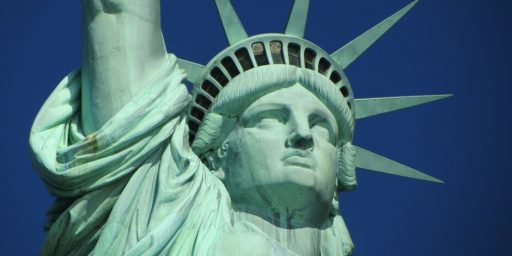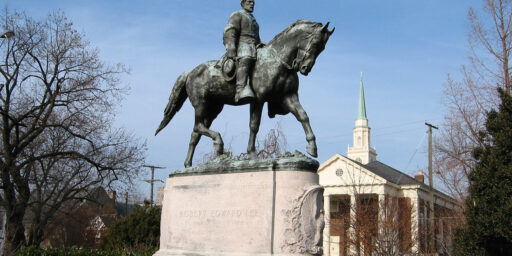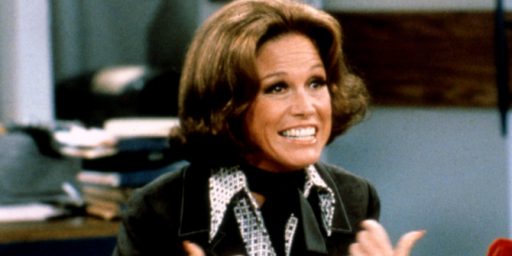VIRGIN FEARS
Peggy Noonan asks, in the subtitle of her WSJ piece today, “Why are rich people afraid of the Virgin Mary?” She begins with a rehash of the issue:
We have all seen the stories this Christmas season–they are not new, they are only more so–of the local struggles between what I suppose might be called the forces of modernity versus the forces of faith. Tussles in schools and townships over the Christmas display, the prayer, the T-shirt, the cross, the statue of Mary. It’s all a continuation of what Michael Kinsley once sardonically referred to as the creche menace. But it has moved beyond the creche: It is increasingly a movement to ban on all public property–and pretty much in public, period–the signs and symbols of a religious holiday that roughly 90% of Americans celebrate. It doesn’t even have to be Christmas-related. Last week there was the story of the Florida housing group that banned a statue of the Virgin Mary from the front of a house in the community.
I’m not sure there’s anything original left to say on this topic. Kinsley’s sardonic jibe encapsulates my view of the issue rather nicely.
Buried in the column is the theme from the subtitle:
You can tool the streets of working class Lodi, N.J., and see little Marys in the front and back yards and no one says boo. But you can go from one end of Park Avenue to the other, and never–and I mean never–see a Virgin Mary in a window or a roof garden. I know. I have searched. There are Catholics on Park Avenue, but mostly there are rich people. And believe me the rich of Manhattan seem either not to like religious symbols or they know to keep them to themselves. Display is vulgar (and working-class).
The rich are lucky, but they are also human. Like most humans they think they have what they have only because of their efforts; or, as is often the case in America, they’ve been lucky so long they think they deserve it. They think they got it because they made better decisions and more sober choices. I think they forget God had anything to do with it. Displaying the signs and symbols of faith is just not very . . . Park Avenue.
Of course, the rich are also likely better educated. But there’s something to this argument: It’s not just religious symbols but most symbolism that is eschewed by the upper class. I’d guess that one sees a lot fewer American flags being flown, Yankees caps being worn, and bumper stickers on display on Park Avenue than in Lodi, too. Also, much less hollering across the street at the neighbors, shooting off fireworks on the 4th of July, and loud music blaring from the car stereo. Similarly, the wardrobes likely consist of more earth tones and blacks and fewer pastels and jewel tones.






…and Mercedes Benzes, Gucci handbags, Waterford Crystal… etc. Not so much hollering across the street, but certainly reading the right books and attending the right parties that have the proper champagne. The rich aren’t immune from symbols; they just choose a different set.
I always had you figured for a closet Kinsley-ite.
Exactly right. It’s a class thing. Indeed, part of the appeal to the rich of their symbols is that the uninitiated don’t recognize them.
You swerve past the truth.
Religion is simply not fashionable today. There are those today who consistently insult the religious and insinuate that more intellectual people know better.
There has been a concerted effort among many of the “intellectuals” to disparage people of faith. Is it any wonder it has become passe?
If all year long your pal Buffy at the club mocks people of faith are you going to put a religious icon in your “holiday” decorations?
The only thing the folks on Park Ave fear more than losing money is losing status.
Paul,
I love your last sentence. Sadly, though, the disparaging of faith is not a new trend. Think about the intellectuals in the French Revolution and then throughout the 19th and 20th centuries.
However, as I have argued elsewhere, at least in the U.S., this “anti-clericalism” (for lack of a better term) is going to have a reverse impact. When religion is attacked in the US, the religious tend to become invigorated (because they have the freedom to do so, which they do NOT in Europe). Religion is still alive and well in the US and it will roar in ’04. The Lawrence decision, removing Roy Moore,* MA gay marriage, the Episcopal gay bishop, the Pledge of Allegiance, etc. will really wake the religious vote up in the coming election. Religion is still alive and well in the US; it’s Nietzsche who is dead.
* My opinion on Moore is that he was pretty boneheaded to push the Ten Commandments issue as far as he did, but it was equally boneheaded to get him removed from the bench. While it may have been appropriate from some legal standing, it was a bad POLITICAL mistake for those wanting to keep future Moore’s off the bench. Kicking Moore of the bench on this was akin to Lehigh’s football team running up the score against Oklahoma’s scout team in a scrimmage, not realizing that Lehigh will have to play Oklahoma next week.
** I also happen to like James Taranto’s “Roe effect” argument that has appeared on Opinion Journal now and then.
As always John, you make many good points.
Now that Dean found Jesus I’m sure he is hoping you are right! 😉
P
Or should I say- Now that Dean has announced that he was going to find Jesus if it would get him votes.
I think some of you are oversimplifying things; Here’s a reality check:
1) Michael Kinsley once sardonically referred to as the “creche menace”
Another gross oversimplification: Its an issue of state sponsored/endorsement of one religon over another (or an absence of religon). It seems like a simple issue, but so many people seem to have a hard time with it.
Seperation of Church and State people. Is that so difficult to comprehend?
2) “Religion is simply not fashionable today”
Actually, church attendance –despite the preist sex scandal — is at multi decade highs; So too the % of Americans who identify themselves as either “religous” or “Very religous.”
Whether its fashionbable or not, religon in America is thriving todday.
3) “If all year long your pal Buffy at the club mocks people of faith are you going to put a religious icon in your “holiday” decorations.”
If Buffy at the club is the reason you aren’t displaying a religous icon, then what does that say about your level of faith and committment? It certainly makes for an amusing chat with St. Peter at the gates of heaven: “You see, I was going to display religous icons, Pete, but the peer pressure at the club was simply too overwhelming.”
Sure it was. C’mon folks, get real.
4) “but it was equally boneheaded to get him removed from the bench”
He violated orders from the highest court in the state, and from a superior Federal court. There was no option but to remove him. Any time a renegade judge decides NOT to enforce the law, he needs to be removed, plain and simple.
Moore got tossed from the bench because of his failure to uphold his obligation to enforce the law as written — not to be a dictiator in his own fiefdom. In reality, it had nothing to do with the 10 commandments.
Think of the Moore issue as roughly parallel to the “Not the crime but the cover up” issue we see so many politicians fall to.
5) “part of the appeal to the rich of their symbols is that the uninitiated don’t recognize them”
There is a thriving black market business making low cost, hi quality imitations of these symbols. Knock offs of Louis Vitton & Prada handbags are very hot in Manhattan. Trust me, the uninitiated know all the symbols . . .
~~~~~~~~~~~~~~~~
This all boils down to a seperation of worship and secular activities. Why on earth is it in the purview of schools and courts and other governmental units to display religous icons? I pay taxes to support my local fire department to PUT OUT FIRES — not to display thir own personal religous beliefs — thats what the fireman’s homes are for.
How about we let these organizations do their actual jobs, and let people worship in the churches of their choice?
Why not allow firefighters to display icons appropriate to the faiths of all who are there? Barry–they do, after all, have to live in the firehouses for days/weeks at a time.
A lot of PC silliness masquerades as “separation of church and state.”
Thomas Jefferson – you know, the “wall between Church and State” guy – instituted a state-wide fast day as governor of Virginia. He saw various religions (without church buildings of their own) using government buildings for worship services as a good thing. If firefighters want to make *their* environment reflect their personal beliefs, why shouldn’t they. I’ve always heard they are tight units and would surely allow all members to participate. It really is a religion thing. If they had posters about global warming up all over, no one would say peep (and global warming is a matter of faith in my opinion).
Barry I don’t know that I have ever seen someone make a goofier argument.
This has NOTHING to do with church and state! We are talking about private property.
Good God, pay attention.
And your link goes to something called “bigpicture” somehow I doubt it.
“Buffy at the club.” Ha ha ha. Those rich people and their obsession with status.
Fortunately our current President is a common man, a cowboy who grew up on a ranch. He is godly and good and leads our country.
—